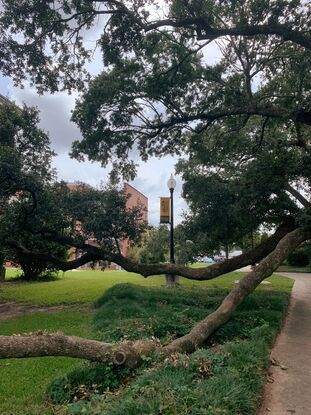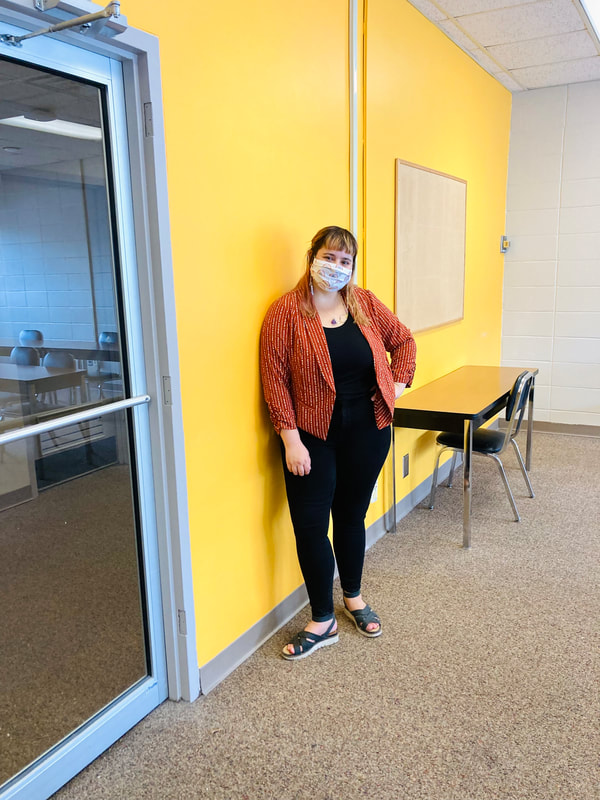 The last two weeks have felt overwhelming and challenging, with Hurricane Ida making landfall the weekend before Week 2 of our sixteen week semester. The University of Southern Mississippi canceled classes on the first Monday of Week 2 because they weren’t sure what weather Hattiesburg would get because of the Category 4 hurricane approaching. School started back on Tuesday after the storm turned east, and Hattiesburg received little destruction as a result. However, many of USM’s faculty, staff, and students are from Louisiana like I am. From our icebreaker activity on day one, I knew that a little over one-third of my classroom was from a city in Louisiana that was navigating the impacts of terrible flooding and extreme wind damage. That week, the class was already scheduled as an asynchronous course. Ahead of the hurricane, I prepared an overview video explaining how to navigate module week two on Canvas, find the instructional videos and complete assignments. I scanned the textbook pages assigned reading because the school bookstore had not yet received copies of the books. I also sent an announcement via Canvas reminding students about the week ahead, and I included hurricane tips for those who had yet to live through a hurricane. It ended up being a good move on my end to have completed these tasks before the hurricane made landfall because the aftermath impacted my family, and I wouldn’t have been available in the same capacity early in the week. I hosted my office hours this week on Zoom. Going into week 3, I received news from the University that we would be in person for the duration of this semester. Previously, we were waiting to confirm this was the case as COVID-19 cases increased across the state. Knowing that I would be teaching synchronously in person, I prepared my lesson plan accordingly. With Labor Day taking one of two class days away from my time with these students, I prepared for Wednesday’s class to be complete and involved. Ahead of Wednesday’s class, I printed off handouts outlining the peer review expectations with guiding questions. I also made name cards for each student and brought loose-leaf paper for our in-class writing activity. Arriving at class a few minutes early, I prepared the technology I would use and played an album on YouTube as students came in. I also wrote the class objectives on the board:
At precisely 1 pm, I began class by handing out their name cards. As I called names and passed out the papers where I had folded them into three parts and written their names in sharpie, I explained how I would take attendance in this class. I prepared these name cards to get to know students names and so both their peers and myself could see their names if we wanted to reference something they said in the discussion. Also, that’s how I would know who came to class based on whose name cards were given out and whose were not. At the end of each class, I expected them to return their name card to the bin by the door. Next, I reminded them of their upcoming rough draft due for their first major visual analysis assignment. I explained the importance of peer review and told them that we could do our peer review one of two ways. Option A was to read each other’s drafts over the weekend, answer the questions in complete sentences, and draft their answers as a letter to their peers. Option B was that they could reach each other’s drafts over the weekend, answer the questions briefly in bullet points, and then on Monday in class, we would split up into their small groups to give more comprehensive verbal feedback. They would use their bullet point notes as a jumping-off point to remind them of their comments for the class peer review. I explained why voting in the classroom was a good idea and why I liked to involve their opinions. 20/21 students voted for Option B. I shared a PowerPoint with them that I had already uploaded to their canvas Module that morning. I began the day’s presentation with a review of what we had learned the week before when we had been asynchronously learning. For this review, I used the student’s quotes from their discussion post #1 and discussion post #2 to define the fundamental concepts of our unit. Although the students did not want to read their comments, I could tell it was a surprise to see a teacher involve their work in the class learning. To bring these concepts together, I showed them a Cajun meme and together, we applied our key concepts to the image, a Cajun meme, which is a particular thing with needed context and a niche audience. My lecture, purposefully called a mini-lecture because it was intentionally short, continued by highlighting the unit's key points, including context, the importance of a good thesis, how to write one, and a few additional details regarding composing a visual analysis. I paused for questions, but students did not have any. I followed the presentation with a short in-class writing assignment that I collected. Our last activity for the day was reading an example of visual rhetorical analysis and talking about it. I set a timer for 12 minutes and played study music in the background while reading the example independently on their phones or computers. While they read, I wrote a chart on the whiteboard with two columns. After the timer, I asked students to pair up with their desk buddy (each desk has two seats) and talk about one thing they thought was excellent about the example, and one thing they thought could’ve been improved. After a few minutes, I asked them to call out their answers. Together, we filled in the columns on the board. Looking at our remarks from the example, I explained what they may want to look out for as they write their visual analysis. With only a few minutes left in the class, I reminded them of the upcoming deadlines and my office hours. As they left, they deposited their name cards where I asked, and many wished me a good day or told me goodbye. Looking back on the class, I thought that we packed a lot into the hour and fifteen minutes and that the students were good participants. I felt like the classroom's energy was good and that teaching in-person probably has something to do with that excitable energy. The students were well behaved if a little rigid. One of my objectives is to see them loosen up during the semester and be more at ease in the learning environment. Preparing for next week, I did feel as though my transitions between tasks were a little choppy and less seamless as they could’ve been. As I draft my lesson plan for my upcoming classes, I want to consider how to transition from one item to another. I know that we are our own worst critics, and it’s even possible that the students didn’t notice my less-than-seamless transitions. However, it is something I can work on, and therefore I will. This past week in my Comp/Rhet Theory class we discussed teacher response at length. As their first major assignment deadline approaches, I’ve been thinking more critically about my feedback on their short assignments. Thinking about giving more facilitative feedback than directive helps make my ideas about student response more concrete. Although I think a good rule of thumb is to extend kindness and aim to support students in their educational journeys – not tear them down – and that’s something I never had to be taught to do. There are more intentional ways to give helpful feedback beyond just extending empathy (necessary but not complete).
0 Comments
Leave a Reply. |
AuthorEmily M. Goldsmith (she/they) is a queer Cajun poet originally from Baton Rouge, Louisiana. They are currently a Ph.D. student at the University of Southern Mississippi. Archives
November 2021
Categories |


 RSS Feed
RSS Feed